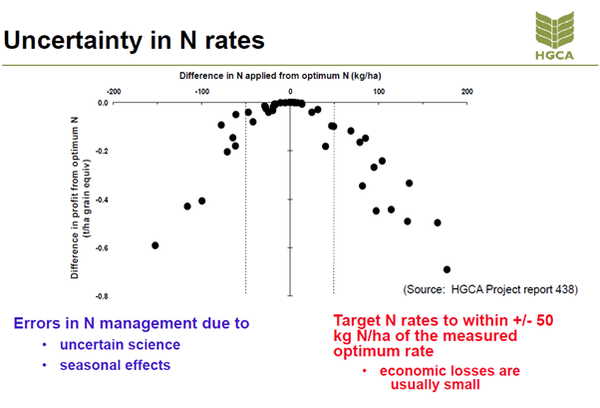A few months ago I attended a seminar at which all of the farmers present said that they had abandoned the precision application of nitrogen to wheat. This came as no surprise to me as I am unaware of a strong scientific base to support it. On the contrary, the scientific arguments against it keep strengthening.
One key issue is the way that wheat responds to nitrogen. It is possible to stray from the economic optimum by up to 50 Kg N/ha and have only a minor effect on both yield and margin. This is demonstrated by a slide shown to the HGCA (now AHDB cereals and oilseeds) conference a few years back.

Therefore, based on nitrogen response data in individual trials, the economic optimum has to vary very significantly in a field before there are meaningful economic advantages for precision application of nitrogen, provided of course that the average dose is just about right. This overriding basic fact alone explains much of the disenchantment in the precision application of nitrogen to wheat.
Nitrogen trials are carried out in a small part of a field where the level of SMN may not vary much across the trial site. On a field scale SMN levels will vary more significantly and may provide an opportunity for precision application of nitrogen. This approach was tested in a major LINK funded project in the late 1990s. The test fields were divided into a grid and for each section of the grid a SMN measurement was taken and the estimated economic optimum was applied. The result was that the average yield of the grids was no higher than it would have been had the average dose been applied to the entire field.
This is perhaps explained by two factors. First, SMN is not a reliable indicator of soil nitrogen supply and second, SMN has far less influence on the optimum dose than previously supposed. A leading soil scientist told me a few years ago that SMN levels up to 100 Kg N/ha were “merely noise”.
Another possible reason to adopt precision application of nitrogen to wheat could be variations in potential yield across the field. However, yield does not influence the demand for nitrogen fertiliser by as much as suggested in some advisory systems. This is simply because high yielding crops use applied nitrogen and SMN more efficiently. If this is not so, how do you explain plot yields last year of 14 t/ha of wheat being achieved from 220 Kg N/ha in NIAB TAG trials carried out on-long term arable soils receiving no organic amendments? It did seem from these particular trials that additional nitrogen was necessary for plot yields above 14 t/ha.
Finally, there is an argument for spatially applying nitrogen according to the canopy size of wheat. Looking back at the graph at the beginning of this blog, this would typically bring small rewards in yield although it would help ‘even up’ the crop. The reward would be more significant in very variable oil seed rape crops where there is a good relationship between canopy size in the very early spring and the optimum economic dose of applied nitrogen.
You have to understand that the examples I have quoted above for wheat are for feed wheat and I have ignored the critically important issue of the environmental impact of nitrogen. It may be that there is a stronger argument for precision application to milling wheat. However, the understanding of nitrogen nutrition is still relatively rudimentary.
To make progress there needs to be further research at the more basic level. The trouble is that funders are more drawn to projects that offer quick fixes. As far as I can see there are no quick fixes in nitrogen nutrition that will provide the basis for precision application of nitrogen. However, there are those enthusiasts who continue to try to develop a system of precision application of nitrogen that will reap real rewards. I genuinely wish them well whilst reminding them that accurately predicting nitrogen doses for feed wheat to within a few Kg N/ha using the current relatively simplistic recommendation systems is at the moment not possible. The only potential case I can foresee for precision application of nitrogen to feed wheat is perhaps where there are very extreme soil types within a field and/or if there was a way of predicting variations in the efficiency of soil and applied nitrogen use across a field.
Remember, the first rule of precision farming is to assess how much variation there is and then assess whether or not there is an economic advantage in spatially varying an operation in order to correct or minimise it. Good basic and applied science, correctly interpreted, has a significant role to play here.
